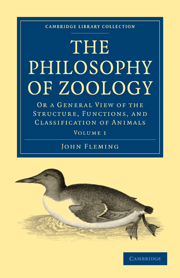 The Philosophy of Zoology
The Philosophy of Zoology Book contents
- Frontmatter
- Preface
- Contents
- Divisions of Natural Science
- CHAP. I Division of Natural Objects into Organised and Inorganic. The Chain of Being
- CHAP. II Peculiar Characters of Organised Bodies
- CHAP. III Distinguishing Characters of Animals and Vegetables
- CHAP. IV On the Polity of Nature
- CHAP. V On the Substances which enter into the Composition of the Bodies of Animals
- CHAP. VI Cutaneous System
- CHAP. VII Osseous System
- CHAP. VIII Muscular System
- CHAP. IX Nervous System
- CHAP. X Organs of Perception
- CHAP. XI Faculties of the Mind
- CHAP. XII Digestive System
- CHAP. XIII Circulating System
- CHAP. XIV Peculiar Secretions
- CHAP. XV Reproductive System
CHAP. V - On the Substances which enter into the Composition of the Bodies of Animals
Published online by Cambridge University Press: 29 August 2010
- Frontmatter
- Preface
- Contents
- Divisions of Natural Science
- CHAP. I Division of Natural Objects into Organised and Inorganic. The Chain of Being
- CHAP. II Peculiar Characters of Organised Bodies
- CHAP. III Distinguishing Characters of Animals and Vegetables
- CHAP. IV On the Polity of Nature
- CHAP. V On the Substances which enter into the Composition of the Bodies of Animals
- CHAP. VI Cutaneous System
- CHAP. VII Osseous System
- CHAP. VIII Muscular System
- CHAP. IX Nervous System
- CHAP. X Organs of Perception
- CHAP. XI Faculties of the Mind
- CHAP. XII Digestive System
- CHAP. XIII Circulating System
- CHAP. XIV Peculiar Secretions
- CHAP. XV Reproductive System
Summary
Although the attention of many eminent chemists has been directed to the examination of the composition of animal bodies, a great deal remains undetermined, in this difficult department of experimental research. The elementary principles which occur in the Animal Kingdom, have been ascertained with considerable precision; but the binary, ternary, or other compounds which these form, have not been investigated with so much success. As these various ingredients are brought into union in the animal system, by the agency of the vital principle, their state of combination may be expected to differ widely from the ordinary results of elective attraction. When such compounds of organization are submitted to analysis, the influence of the vital principle having ceased, the product obtained, may be regarded in many cases as modifications of the elements of the substance, occasioned by the processes employed, rather than the display of the number or nature of the ingredients as they existed previous to the analytical operations. Errors, we know, are to be guarded against in the analysis of mineral waters, arising from combinations taking place during the process, which did not exist in the compound previous to analysis. How much more necessary is it, to exercise caution in drawing our conclusions regarding the composition of animal bodies?
In this section I shall enumerate the elementary bodies, which are considered as entering into the composition of the parts of animals, and then consider the combinations which these form, or the substances in which they have been detected.
- Type
- Chapter
- Information
- The Philosophy of ZoologyOr a General View of the Structure, Functions, and Classification of Animals, pp. 53 - 79Publisher: Cambridge University PressPrint publication year: 2009First published in: 1822


